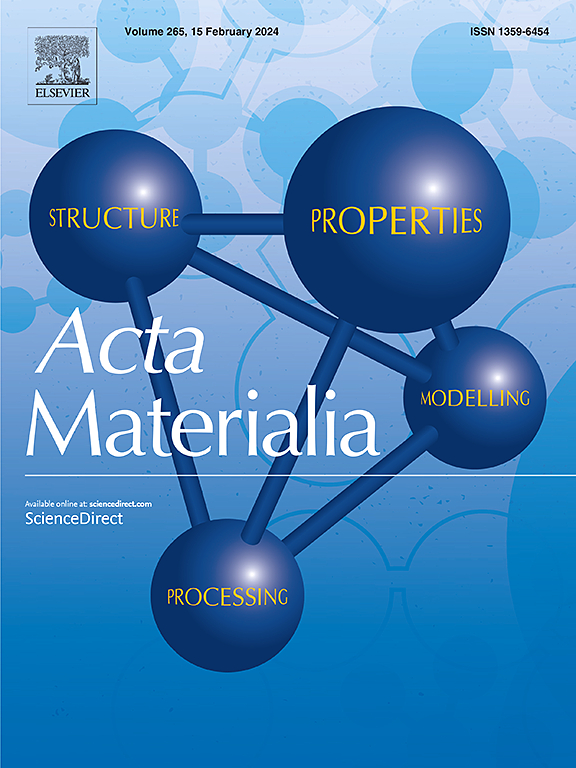亚稳高熵合金中辐照诱导缺陷的演化和偏析:高密度非相干平面缺陷和温度的影响
IF 9.3
1区 材料科学
Q1 MATERIALS SCIENCE, MULTIDISCIPLINARY
引用次数: 0
摘要
强韧的亚稳态高熵合金(HEAs)在多种主元素存在下具有优异的耐辐照性能。本文系统地研究了由面心立方基体和分散σ相组成的亚稳HEA原型的辐照行为,重点揭示了温度和高密度平面缺陷(如晶界和非相干相界)对缺陷演化和偏析行为的影响。透射电镜分析表明,室温辐照后在晶界和σ相界附近形成位错剥蚀带(DDZs), 500℃辐照后在晶界和σ相界附近形成位错富集带(DEZs,主要为断裂环)。这主要归因于温度依赖性缺陷迁移率。500℃辐照后,Co和Ni趋于富集,而Fe、Cr和Mn倾向于在位错环和界面附近贫化,这符合逆Kirkendall机制,并已通过第一性原理计算得到验证。此外,晶粒细化和析出导致室温下ddz体积分数的增加,而缺陷迁移率的增强可以促进缺陷在500℃时的吸收,使其在不同温度下具有更突出的抗辐照硬化性。本研究为具有分散析出相的细晶亚稳态HEAs增强辐照抗辐照性提供了合理的依据,为开发具有优异力学性能的耐辐照合金提供了重要的见解。本文章由计算机程序翻译,如有差异,请以英文原文为准。


Insights into irradiation-induced defect evolution and segregation in metastable high-entropy alloys: Effects of high-density incoherent planar defects and temperature
Strong and ductile metastable high-entropy alloys (HEAs) have potential to achieve excellent irradiation resistance with the presence of multiple principal elements. In this work, irradiation behavior of a prototype metastable HEA composed of face-centered cubic matrix and dispersed σ precipitates was systematically studied with the focus on revealing the effects of temperature and high-density planar defects (e.g., grain boundaries and incoherent phase boundaries) on the defect evolution and segregation behavior. Transmission electron microscopy analysis shows that dislocation-denuded zones (DDZs) are formed in the vicinities of grain boundaries and σ phase boundaries after irradiation at room temperature (RT), whereas dislocation-enriched zones (DEZs, mainly faulted loops) are developed near these interfaces upon irradiation at 500 °C. This is mainly attributed to the temperature-dependent defect mobility. Upon irradiation at 500 °C, Co and Ni tend to be enriched, but Fe, Cr and Mn prefer to be depleted around dislocation loops and interfaces, which follows the inverse Kirkendall mechanism and has been verified by first-principles calculations. Moreover, grain refinement and precipitation lead to increased volume fraction of DDZs at RT, whereas the absorption of defects at 500 °C can be promoted due to enhanced defect mobility, enabling a more prominent irradiation hardening resistance at various temperatures. The work rationalizes the enhanced irradiation resistance in fine-grained metastable HEAs with dispersive precipitates and provides important insights for developing irradiation-resistant alloys with excellent mechanical properties.
求助全文
通过发布文献求助,成功后即可免费获取论文全文。
去求助
来源期刊

Acta Materialia
工程技术-材料科学:综合
CiteScore
16.10
自引率
8.50%
发文量
801
审稿时长
53 days
期刊介绍:
Acta Materialia serves as a platform for publishing full-length, original papers and commissioned overviews that contribute to a profound understanding of the correlation between the processing, structure, and properties of inorganic materials. The journal seeks papers with high impact potential or those that significantly propel the field forward. The scope includes the atomic and molecular arrangements, chemical and electronic structures, and microstructure of materials, focusing on their mechanical or functional behavior across all length scales, including nanostructures.
 求助内容:
求助内容: 应助结果提醒方式:
应助结果提醒方式:


